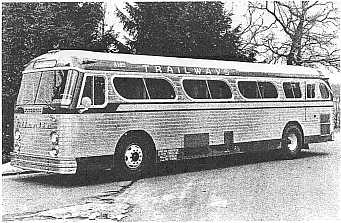
| An air-conditioned version of the 37-passenger Roadrunner for Atlantic Stages of Macon, Ga. which had two. Cummins diesel power was used. |
|
Large versions of the Duraliner continued to be sold in Mexico until 1956; FitzJohn had established a distributorship in Mexico City shortly after World War II. Perhaps an important factor in this continuing success was the poor roads, often unpaved, which made front engine buses more practical. Dust blowing up under and into a rearmounted engine could cause serious problems. Nevertheless, the bottom dropped out of this particular part of FitzJohn's market in the mid-1950's, when the Mexican government decided to encourage auto, truck and bus production in that country, and import permits became hard to get.
The Roadrunner Meanwhile, the intercity bus industry in the United States took to silversides, picture windows, air suspension and rear-mounted diesel engines. Faced with declining business for its standard offerings, FitzJohn scrapped all of its existing models and introduced the Roadrunner in 1954. For the last few years of the company's existence, :the Roadrunner (officially the FID and FIG, for FitzJohn Intercity Diesel or Gas) was the basis of its production. .
"Just like its namesake," said the advertising, "which can outrun a man or horse, displays wonderful maneuverability, makes quick stops when it senses danger, and
| Of the 111 Roadrunners, 13 were designated "Roadrunner Sightseers" and built with tinted roof windows. Only two Gray Line companies had them--Boston had three and Philadelphia two. |
|
10